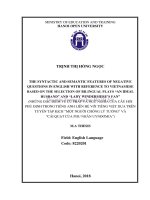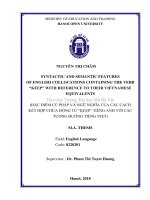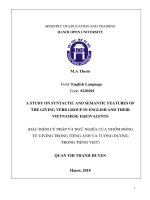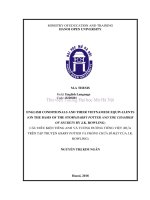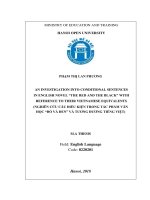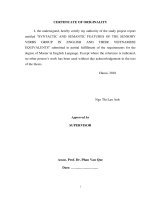ENGLISH CONDITIONALS AND THEIR VIETNAMESE EQUIVALENTS (ON THE BASIS OF THE BOOK HARRY POTTER AND THE CHAMBER OF SECRETS BY j k ROWLING)
Bạn đang xem bản rút gọn của tài liệu. Xem và tải ngay bản đầy đủ của tài liệu tại đây (2.47 MB, 116 trang )
MINISTRY OF EDUCATION AND TRAINING
HANOI OPEN UNIVERSITY
M.A THESIS
Field: English Language
Code: 8220201
ENGLISH CONDITIONALS AND THEIR VIETNAMESE EQUIVALENTS
(ON THE BASIS OF THE STORYHARRY POTTER AND THE CHAMBER
OF SECRETS BY J.K. ROWLING)
CÂU ĐIỀU KIỆN TIẾNG ANH VÀ TƢƠNG ĐƢƠNG TIẾNG VIỆT (DỰA
TRÊN TẬP TRUYỆN HARRY POTTER VÀ PHÒNG CHỨA BÍ MẬT CỦA J.K.
ROWLING)
NGUYỄN THỊ KIM NGÂN
Hanoi, 2018
MINISTRY OF EDUCATION AND TRAINING
HANOI OPEN UNIVERSITY
M.A Thesis
Field: English Language
Code: 8220201
ENGLISH CONDITIONALS AND THEIR VIETNAMESE EQUIVALENTS
(ON THE BASIS OF THE BOOK HARRY POTTER AND THE CHAMBER
OF SECRETS BY J.K. ROWLING)
CÂU ĐIỀU KIỆN TIẾNG ANH VÀ TƢƠNG ĐƢƠNG TIẾNG VIỆT (DỰA
TRÊN TẬP TRUYỆN HARRY POTTER VÀ PHÒNG CHỨA BÍ MẬT CỦA J.K.
ROWLING)
NGUYỄN THỊ KIM NGÂN
Supervisor: Assoc. Prof. Dr. HỒ NGỌC TRUNG
Hanoi, 2018
STATEMENT OF AUTHORSHIP
I, the undersigned, hereby certify my authority of the study project report entitled
English conditionals and their Vietnamese equivalents (on the basis of the book
Harry Potter and the Chamber of Secrets by J.K. Rowling) submitted in partial
fulfillment of the requirements for the degree of Master in English Language.
Except where the reference is indicated, no other person‘s work has been used
without due acknowledgement in the text of the thesis.
Hanoi, 2018
Nguyen Thi Kim Ngan
Approved by
SUPERVISOR
Assoc. Prof. Dr. Ho Ngoc Trung
Date:……………………
i
ACKNOWLEDGEMENTS
This paper could not have been completed without the help, encouragement and
support from a number of people who all deserve my sincerest gratitude and
appreciation.
First and foremost, my deepest thanks are due to my supervisor Assoc. Prof.Dr. Ho
Ngoc Trung for his invaluable advice, generous assistance and continual
encouragement in completion of this study. His continual encouragement, careful
reading, critical comments and patient guidance made my work more enjoyable and
easier.
My thanks also go to all lecturers of the Faculty of Graduated Studies, Hanoi
Open University who taught me valuable lessons.
I would also like to send my thanks to all my informants for their willling
participation in the study. I greatly appreciate their generosity with their time and
efforts in filling in the questionnaire. Without them this paper could not have been
possible.
Last but not least, I would like to express my heartfelt gratitude to my family
members who have constantly supported, inspired and encouraged me to complete
the graduation paper.
ii
Abstract
This study comparatively analyses the structures and pragmatic features of English
conditionals and their Vietnamese equivalents. The analysis is based on the types
and other forms or phrases of the conditionals in the languages under study. The
study analyses both secondary and primary data upon which its conclusion is based.
In the analysis, the study has used the Speech Act theory and shown that there are
the structures and pragmatic features in the conditionals of the two languages under
study. For example, English has several conditional markers including if;
Vietnamese has several conditionals markers (nếu…thì, giá mà…thì…). Other
differences include the use of (in Vietnamese conditionals as opposed to English
counterparts) a whole sentence represented either by subject and verb or by a verb
plus an enclitic. It is evident from the findings that conditional clauses account
largely for tools mostly used in conversation in both Vietnamese and English, in
oral and written discourse, though the written discourse is not discussed here. When
used in conversation, initialized if - clauses can be used to give directives, speak
humorously and sarcastically and offer apologies, commands, advice and
instructions. The analysis has in addition shown factors that determine the position
of the if-clause. The conditionals are seen as reflecting the psychological thoughts
and the state of speaker (rebuke, request). These aspects are shown in the use of
predictive and future temporal conditionals by both Vietnamese and English
speakers. The study on the whole has contrasted conditionals in Vietnamese and
English at forms and usages levels. The study recommends further studies on
conducting a comparative analysis of English and Vietnamese.
iii
List of tables
Table 2.1: structure of Zero type……………………………………………….......19
Table 2.2: structure of First type …………………………………………………..20
Table 2.3: Structure of Second type ……………………………………………….21
Table 2.4: Structure of Third type………………………………………………….21
Table 2.5: Structures of four conditionals types …………………………………23
Table 2.6: Table 2.6: Vietnamese interrogative forms…………………………….30
Table 3.1: Answers made by students
when choosing types of conditionals …………………………………..36
Table 4.1: The ways to translate Conditionals
based on four types …………………………………………………....58
List of diagrams
Diagram 3.1: Errors made by students
when using conditional conjunctions ………………………………..…36
Diagram 3.2: Common errors made by students
when using pragmatic functions and translating conditionals…....37
List of charts
Chart 4.1: classifications of Zero type in the book ……………………………….40
Chart 4.2: Basic types of conditionals in the book ………………………………..49
iv
TABLE OF CONTENTS
Chapter I: INTRODUCTION .................................................................................. 1
1.1 Rationale .......................................................................................................... 1
1.2 Aims of the study ............................................................................................. 2
1.3 Research questions .......................................................................................... 2
1.4 Methods of the study ....................................................................................... 2
1.5 Scope of the study............................................................................................ 3
1.6 Significance of the study ................................................................................. 3
1.7 Design of the study .......................................................................................... 3
Chapter II: LITERATURE REVIEW .................................................................... 5
2.1 Previous studies ................................................................................................ 5
2.2 Mood and tense ................................................................................................ 6
2.2.1 Mood.............................................................................................................. 6
2.2.1.1 Concepts of mood ......................................................................................6
2.2.1.2 Types of Mood ...........................................................................................7
2.2.2Tense............................................................................................................... 9
2.2.2.1 Concepts of tense .......................................................................................9
2.2.2.2 Types of Tense ...........................................................................................9
2.3 English Conditional ...................................................................................... 11
2.3.1 Definitions ................................................................................................... 11
a. Concepts of Conditional sentences ............................................................. 13
b. Types of English conditionals ..................................................................... 14
2.3.1.1 The Zero conditionals ............................................................................14
2.3.1.2 The First conditionals ............................................................................15
2.3.1.3 The Second conditionals .........................................................................16
2.3.1.4 The Third conditional ............................................................................17
2.3.1.5 The Mixed conditionals..........................................................................18
2.3.2English conditional conjunctions ............................................................... 19
2.3.3Conditional meanings ................................................................................. 19
2.3.3.1 Real and Unreal .......................................................................................20
2.4 Vietnamese Conditionals .............................................................................. 21
2.4.1 Concepts of Vietnamese conditionals ....................................................... 22
v
2.4.2Types of Vietnamese conditionals ............................................................. 23
2.4.2.1 Assumption conditionals (Câu điều kiện dự báo giả định) .................23
2.4.2.2 Unreal assumption conditionals (Câu điều kiện phản thực) ..............24
2.4.2.3 Inferential conditionals (Câu điều kiện suy luận) ...............................24
2.4.2.4 Speech act conditionals (Câu điều kiện hành động ngôn từ) .............24
2.4.2.5 Superlanguage conditionals (Câu điều kiện siêu ngôn ngữ) ..............27
2.4.2.6 Comparative symmetry conditionals (Câu điều kiện so sánh đối
xứng) ..................................................................................................................27
2.5 Conditionals in Speech Act theory .............................................................. 27
2.6 Summary of chapter ..................................................................................... 30
Chapter III: METHODOLOGY ........................................................................... 31
3.1 Subjects .......................................................................................................... 31
3.2 Instruments .................................................................................................... 32
3.3 Procedures ..................................................................................................... 33
3.3.1Data collection procedures ......................................................................... 33
3.3.2 Questionnaire ............................................................................................. 33
3.4 Statistical Analysis ........................................................................................ 33
3.5 Summary of the chapter ............................................................................... 35
Chapter IV: ENGLISHCONDITIONALS AND THE VIETNAMESE
EQUIVALENTS ...................................................................................................... 37
4.1 Structural features of conditionals in Harry Potter and the Chamber of
Secrets. .................................................................................................................. 37
4.1.1 The Zero conditionals ................................................................................38
4.1.2 The First conditionals ................................................................................41
4.1.3 The Second Conditionals ...........................................................................43
4.1.4 The Third conditional sentences ...............................................................46
4.1.5 The Mixed conditional sentences ..............................................................47
4.2 The pragmatic functions of conditionals used in the book ........................ 49
4.2.1 Rebuke ........................................................................................................ 51
4.2.2 Lamentation................................................................................................ 51
4.2.3 Argumentation ........................................................................................... 52
4.2.4 Request ........................................................................................................ 52
4.2.5 Assertion ..................................................................................................... 53
vi
4.2.6 Manipulation .............................................................................................. 54
4.2.7 Exhortation ................................................................................................. 54
4.2.8 Mockery ...................................................................................................... 55
4.3 The ways of translating English conditionals into Vietnamese ................. 56
4.3.1 Translating English conditionals based on the Types ............................ 56
4.3.2 Translating English conditionals based on the Pragmatic fuctions ......59
4. 5 Implications for Vietnamese learners to study English conditionals ...... 60
4.4. Summary of the chapter ............................................................................... 61
Chapter V: CONCLUSION ................................................................................... 62
5.1. Summary of findings .................................................................................... 62
5.2 Concluding remarks ...................................................................................... 62
5.3 Recommendation for Further study ............................................................ 63
REFERENCES ........................................................................................................... i
APPENDIXES .......................................................................................................... iv
vii
Chapter I: INTRODUCTION
1.1 Rationale
In daily conversation, we communicate with a variety of sentences to express
our thoughts; very often we use representative utterances in form of conditionals to
perform a logical relation between the condition and the conclusion, the
consequence… However, in many cases; we employ conditionals not to express a
descriptive message about logical relation between the real and unreal condition and
the judgment about the likelihood of the possibility of a state-of-affair. In fact, the
condition described in these cases is found to have a specific function other than a
description of the condition for a normal conditional sentence. Rather, the
conditionals are assumed to express many meanings from speakers: hoping,
warning, threatening…. This linguistic fact raises a question about a kind of
conditionals concerning their linguistic features. Being a young teacher of English, I
always wonder how to inspire my students in learning English to get good result
after a term. After a long time, I realize that good knowledge and high score is not
enough. We need to have good language behavior whenever we contact the
foreigners and how can we use language to achieve our purpose. It depends on our
ability in communication. In this respect, I decide to do my research on the
linguistic features of conditionals in communication and translation. We will
support some special view of the phenomenon of conditionality. The main objective
will be simply to study structures and pragmatic features of English conditionals:
―English conditionals and the Vietnamese equivalents (on the basis of the story
Harry Potter and the Chamber of Secrets by J.K. Rowling)‖. The findings are
expected to find out the forms and usages of conditionals between English and
Vietnamese. Therefore, it can help the learners get success in communication or
studying English and help us understand and have good manipulative skills of using
language in each conversation.
The realization of conditional meaning has been a puzzle and has seemingly
escaped uniform descriptions and interpretations. Because of this, conditionals have
been an object of study in such fields as syntax, semantics and pragmatics. Many
studies are successful in comparatively analyzing the syntax and semantics of the
conditionals in English and in Vietnamese. There is hardly any study that has been
done to examine how particular meanings are assigned to different types of English
1
conditionals with reference to Vietnamese. This particular research, therefore, was
set out to investigate whether there is any relationship between Vietnamese and
English conditionals with regard to their pragmatic features.
1.2 Aims of the study
The study is to help learners of English use conditionals in English
effectively when knowing the structures and the usages of conditionals.
As a result, the objectives of the study are:
Investigating the forms of conditionals in the story Harry Potter and the
Chamber of Secrets;
Discovering the pragmatic functions of conditionals in the story;
Examining
how
English
conditionals
aretranslatedinto
Vietnamese
effectively.
This study has been completed to suggest some implications for translating
and learning English conditionals effectively.
1.3 Research questions
To perform the objectives, the research will answer the following questions:
1. What are the forms of English conditionals in the story Harry Potter and the
Chamber of Secrets?
2. What are the pragmatic functions of English conditionals in the story Harry
Potter and the Chamber of Secrets?
3. How are English conditionals translated into Vietnamese?
1.4 Methods of the study
The qualitative and quantitative research approaches are the two paradigms
that guide the direction of a research paper from the initial stage to the time of
writing the final report. In this particular study, the researcher used the qualitative
approach owing to its suitability in social research and the fact that it can be applied
in the subjects‘ natural environment (De Vos, 2001). In addition, the rationale
behind the choice of the qualitative approach is centered in its strengths. It is
flexible and emphasizes people‘s lived experiences, their perceptions, their
assumptions and their presuppositions as connected the world around them
2
(Neumann, 2006). In qualitative research, the researcher collects data right from the
participants. In this study, the researcher collected data from Vietnamese students,
who had 10 years learning English gradually in schools.
This quatitative research aimed at unearthing detailed information on English
conditionals, how they formed syntactically as well as linguistic factors that initiate
their use in social discourses. The selection of Vietnamese speakers with English
proficiency was to enable the researcher to have a good understanding of
Vietnamese conditionals.
1.5 Scope of the study
This study focuses on syntactic and pragmatic features of conditionals in
English and Vietnamese to use as a source material for learners and teachers.
However, due to the time and the length limit, this paper is confined to the instances
of 294 conditionals from the book ―Harry Potter and the Chamber of Secrets‖ by J.
K. Rowling. This research carried out a survey inNguyen Van Cu High School in
Tu Son, Bac Ninh with 128 students in three classes of grade 12.
1.6 Significance of the study
This paper focuses on describing and analyzing the structures and usages of
English conditionals described in grammatical books, then examining their usage in
different communication circumstances in the book ―Harry Potter and the Chamber
of Secrets‖. Besides, the paper will also find out the frequency of conditionals in the
book ―Harry Potter and the Chamber of Secrets‖ to hypothesize the presence of
these conditionals and its Vietnamese equivalents. Last but not least, the paper
suggests some implications for translating English conditionals.
1.7 Design of the study
Tne study is designed into five chapters.
Chapter I: Introduction provides rationale of the study, research problems, aims and
objectives of the research, the significance of the study and the scope of the
research.
Chapter II: Literature Reviewsummarizes, synthesizes and reviews critical points of
relevant published works. Concepts that are mentioned in the theoretical
3
background of interpreting include: overview of mood, tense and English
conditionals. It has shown some concepts and classification of Vietnamese
conditionals.
Chapter III: Methodologyexplains what methods are employed for data collection
and analysis looks at the selection of subjects and the procedures of data collection
and analysis
Chapter IV: Findings and discussionsfinds out the basic types and most common
forms of conditional sentences that appeared in the novel as well as their pragmatic
functions, the frequency of conditionals and its Vietnamese equivalents. Then, lists
out the current mistakes of using conditionals and suggests some implications for
translating English conditionals.
Chapter V:Conclusion summarizes the main features of conditionals in answer to
the three research questions, condenses the limitations, and proposes some
suggestions for further studies.
4
Chapter II: LITERATURE REVIEW
2.1 Previous studies
Conditionals have been mentioned in a number of previous studies not only
in English but also in Vietnamese. There are some points of view about the
structures and usages of Conditionals. According to A. J. Thomson, A. V. Martinet
(1986), Raymond Murphy (1994), B. D. Graver (1986) and John Eastwood (1997),
conditionals are classified into different types based on two criteria: physicalism
(real – unreal) and time (past – present – future).
Moreover, type 0 (zero) is added to indicate condition – consequence by B.
D. Graver and John Eastwood. Meanwhile A. V. Martinet and Betty Schrampfer
Azar put it in type 1 as consequence, habit and truth. In addition, Martinet, Azar and
Eastwood mentioned a mixed type such as 1 – 3, 2 – 3, 3 – 2.
In universal grammar, the linguists such as Fillmore (1986), Langacker
(1987) have applied prototype theory on linguistic analyses. Eve Sweetser in From
Etymonogy to Pragmatics (1990) classified conditional semantics into three
domains: content, epistemic and speech act domain.
It is understood that content-based conditionals are relating the content of the
two clauses mutually. The content conditionals can be understood is for the P clause
to identify a situation, which causes or automatically results in the state of affairs
signaled by the Q clauses.According to Quirk et al. (A Comprehensive Grammar of
the English Language), there are four main types such as the Zero Conditional
(cause and effect), the First conditional (open), the Second Conditional (unreal) and
the Third Conditional.
Nguyen Khanh Ha (2008) mentioned prototype theory and prototype
conditionals in Vietnamese. Le Thi Minh Hang (2009) examined the causal relation
and conditionals. She has explained and demonstrated all kinds of conditionals. Vu
Thi Nga (2009) has analyzed conditional hedges in Vietnamese communication
utterances. She examined a lot of different communicative situations especially in
Vietnamese literature.
In Practical English Grammar (Dang Thi Huong. 1998), the conditionals
were approached from the view of two separation clauses and Mood categories.
According to the author, the IF clause was categorized, depending on the speaker‘s
5
conception, the indicative and subjunctive (based on the correlation of tense and
time); the main clause included Infinitive and Modal and would be changed if it
referred to the past, present or future. This system came from the perspective of
theory and conditional problem was solved flexibly. However, when applied in
practice, this approach is obviously difficult for the readers who are not English
majors.
Võ Thị Kim Anh (Different Ways to Express Condition andConcession in
English and Vietnamese - M.A thesis,2010) stated thatcondition-consequence
relation is often described as ―If P then Q‖. Herarticle just focused on conditionconsequence expressed by subordinatingconjunctions. Pragmatic functions of
conditional sentences concerning10illocutionary act in English and Vietnamese:
threatening, advising, warning,criticizing, offering, requesting, regretting, and
softening are discussed.
In this research, the author has described and analyzed the types of English
conditionals both in the sentences If and in other sentences with conditional
conjunctions. Pragmatic functions of conditionals are shown in the paper.
Therefore, some suggestions are mentioned to help Vietnamese learners master
translating of English conditionals.
2.2 Mood and tense
2.2.1 Mood
2.2.1.1Concepts of mood
Mood is a group of verb forms expressing a particular attitude. It might also
bedefined as a grammatical category in specific languages. English, for example,
theindicative mood, expressing factual statements, the imperative mood, expressing
commands and the subjunctive mood, expressing possibilities and wishes
(EncartaDictionaries, 2009).
Some authors have mentioned the concept of mood in their book. According
to E.M.Gordon and I.P.Krylova: ―Mood is the form of which shows the relation
between the action expressed by the predicate verband reality‖. This relation is
established by the speaker who may wish to present an action as a real fact or as a
command (a request) or as something unreal, something that does not exist in
reality. V. Vinogradov also expressed the same idea in another way:
―Moodexpresses the relation of the action to reality as stated by the speaker‖.
Example:
6
1. If Lungowe plays tomorrow, we will lose the base ballgame. (indicative)
2. If Lungowe played tomorrow, we would lose the base ballgame.
(subjunctive)
2.2.1.2 Types of Mood
According to M. A. K. Halliday (2004), Mood is classified into
Indicative,Imperativeand Subjunctive. Indicative types are declarative, interrogative
(yes/no and W – H interrogatives).
Furthermore, there have been many views of difficulttypes of Mood; the
most common point is that there are three moods: Indicative, Imperative and
Subjunctive mood.
(i) IndicativeMood
The Indicative Mood shows that the speakers/ writers present the action or
real. Most of what we havesaid is in the indicative mood, most of what anyone says
or writes is in theindicative mood. So, this is the most common mood used in any
language.
We can use indicative mood to give information (I like reading poetry,
wehad dinner at six…), to express opinions (I think she is a good student…) tomake
promises (I shall do everything I can help you…).
(ii) Imperative Mood
Halliday (2004) mentioned that the Imperative has a different system of
Person from indicative since the imperative is the mood for exchanging goods –
services, its Subject is you or me or ‗you and me‘. That is difficult to understand
clearly than other concepts.Simply, the word ―imperative‖ derives from Latin
―imperare‖ command. Imperative Mood expresses command, prohibition, entreaty
or advice
We have the following different kinds of command:
- Command without a subject (Open the door!)
- Command with a subject (Don‘t you worry! or somebody clean the
board!)
- Command with ―let‖ (Let me take your coat! or Let‘s go outside!)
Thus, in English, the imperative verb is severely restricted in tense, aspect, voice
and modality.
(iii) Subjunctive Mood
7
In contrast to the Indicative mood, the Subjunctive usually refers to
nonfactual or hypothetical situations.
There are two types of subjective - the present Subjunctive and the past
Subjunctive.
+ The present Subjunctive:
The present Subjunctive of all verbs is identical with the simple present tense
indicative, except that the third person singular form is the same as in all other
persons (for example: without the ―s‖ ending). The present Subjunctive form of ―to
be‖ is ―be‖ for all persons.
Example: It is necessary that they be told what happened.
In the sentence above, the dependent clause (that…) contains an order;therefore, the
mood should be Subjunctive. Therefore, the verb should be be told rather than are
told.
+ The past Subjunctive:
The past Subjunctive in English consists of the past Subjunctive which is
identical with the simple past tense indicative, except that the verb ―to be‖ has
―were‖ for all persons and the past perfect Subjunctive which is identical in form
with the past perfect indicative. The past Subjunctive is used in conditional clauses
implying a negative, or in clause in which the condition is combined with
improbability or unreality.
Examples:
If I were you I should accept the offer.
If I had worked harder, I wouldn‘t have failed the exam.
Furthermore, the past subjunctive is also used after such expressions as:
- I wish that… (I wish he visited us more often)
- Suppose that… (Suppose (that) the teacher caught us wasting time)
8
Types of Mood
Indicative
Imperative
Mood
Subbjunctive
2.2.2 Tense
2.2.2.1 Concepts of tense
Jespersen (1931:1) states that tense are―the linguistic expression of time
relations‖; Eckersley and Eckersley (1960:157) conclude that tense ―means the
verb form or forms used to express certain time relations. Crystal (1985: 352)
postulates that tense is a category used in the grammatical description of verb
referring primarily to the way the grammar marks the time at which the action
denoted by the verb took place.
Finally, Cormier (1986: 26) gives a wider scope to the definition of tense,
regarding it as the grammaticalization of location in time. Considering the
comprehensive quality of Cormier‘s definition, the researcher believes that it is the
most appropriate among all the other definitions.
2.2.2.2 Types of Tense
a. Present Tense
Cormier (1988:37) states that the present moment is a location fixed in the
time line. Thus, the present tense is the location of the situation at that point. Yet,
this seems somehow a controversial argument since situations that coincide with the
present moment are rare. However, such rare situations do occur. Cormier gives an
example with a performative verb: I promise to pay you ten pounds. Cormier (Ibid.:
9
38) adds that one of the most interesting characteristics of the present tense is that it
can be used to refer to situations that occupy much longer period of time than the
present moment, including the present moment.
Example: The Eiffel Tower stands in Paris.
b. Past Tense
The past tense is used when the happening state, action or event is related to
a definite time in the past, a point that may be called 'then‘. The past tense is the
marked member of the opposition past/ present, as Fowler (1974:42) suggests that
tense in English has only two values from a formal point of view, i.e., [± past]
avoiding the use of ―present‖ in tense opposition. A sentence is either marked (+
past) or unmarked (- past).
c. The Futurity
Traditional grammarians divide time into threefold opposition, i.e., past,
present and future, while structuralisms, being more committed to form than to
meaning, reject the term ―future tense‖ because there is no verb form that can
denote future time like the two forms representing past/ present respectively. Stone,
(1976) states that simple futurity denotes an action with reference to future time or
future intention. It is distinguished by means of two main markers, viz. shall and
will whose function is either to give the meaning of pure futurity or to express
determination or promise. The problem arises, according to Hornsby (1977:45) in
indicating future activities aside from other notions like likelihood, willingness, and
so on. Yet, one can assume that when future events are not inflected by these
notions, i.e., likelihood and the like, we are talking about ―pure future‖.
The objections that have been raised against dealing with a ―future tense‖ is
treated by Daoud (1988:1) who considers tense as a semantic category whose main
function is to express the concept of time in its three dimensions, i.e., past, present
and future. Taking this definition into consideration, Daoud (Ibid.) argues that
―future tense‖ should be treated as an integral part of the English tense-system
though most linguists reject the use of ―future tense‖ since the inflectional
morphology of the English verb does not include any affix that could be regarded as
an explicit marker of future tense.
10
Three main tenses:
past tense
present tense
futurity
2.3
English Conditional
2.3.1 Definitions
While the word if provides a simple function to express conditional thought,
the class of expressions using if are not wholly representative of conditionals at the
level of conceptualization. This paper explores some of the ways that conditionals
are verbalized in English by presenting observations obtained from the book Harry
Potter and the Chamber of Secrets by J.K. Rowling
Semantically, the logical form of the utterance may be enriched (e.g.
Recanati, 2010) or even overridden (e.g. Jaszczolt, 2010) to give the speaker‘s
intended meaning, this research shows that a conditional may either be expressed
overtly via the construction used, or implicitly, where the intended conditional
meaning has to be recovered pragmatically. There is thus a crucial interaction
between semantics and pragmatics in generating a conditional, since the conditional
implicature may be the main, intended meaning (cf. Default Semantics, Jaszczolt,
2010). This suggests that conditionality is dependent on an interaction between
various sources of communication, from the lexicon and grammar, to the speaker‘s
intentions and the topic of conversation.
While conditionals may be expressed either directly or indirectly, this paper
shows that in each conditional expression there is an underlying expression which
uses if. Since in all conditional expressions if is present as a concept, utterances
using if express conditional thought directly using the default, most common
conditional marker. This paper thus shows how conditionals which overtly use if fit
into a broader semantic category.
Besides, with the discrepancies between the material conditional and natural
language conditionals as motivation, Stalnaker (1975) takes a variant truth-
11
conditional approach to the study of conditionals, arguing that if bears a non-truthfunctional relation between its antecedent and consequent. In particular, he argues
that a conditional is true if and only if in the closest contextually available possible
world in which the antecedent is true the consequent is also true.
This account fares better than the truth-functional account in following the
pattern of our conditional thought in that it restricts our consideration of the
consequent to those situations where the antecedent holds. Immediately we have a
more intuitive notion of what a conditional is. However, what should be noted here
is that Stalnaker does not provide us with a definition for what a conditional is, but
an account of the truth conditions of already established conditionals. Therefore, on
the one hand we do not have a method of deciding whether an expression is
conditional, but secondly, this account is only relevant to conditional assertions and
won‘t adequately extend to other conditional speech acts which are not concerned
with truth. We thus require some definition of conditionals which subsume both
conditional assertions and conditional speech acts, and furthermore, a definition
which will allow us to decide whether an expression falls into the class of
conditional expressions.
In his Dictionary of Grammatical Terms, Trask (1992) describes the term
‗conditional‘ as:
A conventional name for certain verb forms occurring in
some languages, notably Romance languages, which
typically express some notion of remoteness, supposition,
approximation or implied conditional.
By defining a conditional as ‗certain verb forms‘ which express an ‗implied
conditional‘, it would appear that there is an element of circularity to this definition.
Nevertheless, there are more important problems when applying this definition to
the current endeavor. Since English does not have any particular tense or inflection
depicting conditional mood, to specify that conditionality refers to verb forms is not
an appropriate definition when applying to conditionals in English. While we could
talk of the conditional tense in English being expressed with would, it is obvious
that we can construct conditional sentences which do not use would, and moreover
that would is not only used to introduce a conditional. What is required is some
12
definition that will subsume the relevant constructions, but will not limit conditional
expressions to specific verb forms.
One aspect of Trask‘s definition which may prove fruitful in shaping our
own definition of conditionals is the notion of ‗remoteness‘. Employing a Gricean
(1967) tack, use of the word if typically signifies that the speaker does not know the
antecedent to be certainly true, and gives rise to a quantity implicature that the
speaker is not in a position to make a stronger statement, for example using since in
place of if. We want to extend this rationale to other conditionals which do not use
if. While if may signify some inherent remoteness from reality, pinning remoteness
on the antecedent more generally removes the burden from the word if. It should
also be noted that by bringing in a notion of remoteness from reality, we implicitly
consider the speaker‘s epistemic stance towards the truth of the antecedent. This
turns the focus away from a grammatical definition of conditionals towards a
pragmatic definition, where the speaker‘s intentions and context of utterance also
have to be taken into consideration.
a. Concepts of Conditional sentences
Bibber, Johansson, Leech, Conrad and Finnegan (1999) argue that, as a
linguistic and cognitive complex structure, the conditional sentence expresses a
myriad of meanings and functions via various manifestations. The conditional is
considered complex since its realization is dependent upon the occurrence of
another event. Conditionals are said to have the ability to express logical arguments,
especially in academic debates to introduce or develop an argument (Bibber et al,
1999). Not only that, literature has shown that they also express cognitive
reasoning, semantic nuances through factual, nonfactual or hypothetical events. In
addition to the said before, conditional sentences can also be used to mitigate the
force of suggestion or command, making it the hearer‘s choice.
(a) If breaking the rule of law is a crime, why then do we see law
breakers walking the streets freely? (Introducing an argument)
(b) If you expose a candle to excessive heat, it will melt. (Factual)
(c) Well, you can join us if you don‘t mind. (Suggestion)
Randolph Quirk in ―University Grammar of English‖ (1972) suggested an idea:
―Conditional clauses state the dependence of one circumstance or set of
circumstances on another‖. Collins Cobuild (1990) in ―English Grammar‖ also
pointed out:
13
―Sentences containing conditional clauses are sometimes called conditional
sentences‖ and as for him conditional clauses begin with ―if‖ or with conjunctions
having similar meaning like ―unless‖.
From the definition above we can define the Conditional Sentence as one
kind of complex sentence of at least two main clauses ―the main clause (result
clause)‖ and ―subordinate clause (if clause)‖ used to express the dependence of one
circumstance or set of circumstances on another and in most of cases two clause
orderings are acceptable. In others words the ―clause‖ sets up the condition for ―the
main clause‖ to produce the result or outcome.
b. Types of English conditionals
To identify the type of conditionals, the mood of the verb is used as key
elements, certain constructions are fairly standard. The verb forms are the
noticeable feature to descript conditionals and to classify. The types of conditionals
are identified as shown subsequently is dependent on the various verb forms used in
both the protasis (antecedent) and appdosis (consequent). Theidentification,
classification and discussion done in this study is inconformity with most
grammarians on conditionals such as (Young,1989), Goodwin cited in (Fintel,
2012), and whose classification of conditional sentences is based on the verb in the
protasis, Robertson also cited in (Fintel, 2012) whose classification basically
follows that ofGildersleeve in classical Greek by identifying four types of
conditionals,each determined by the mood of the protasis. Depending on which
book of grammar one consults, one will find three, four or more English conditional
sentence types referred to (and with slightly different names for each), but
generally, one can say that there are four that are most recognized. These are the
zero conditional, the first conditional, the second conditional, the third conditional
and the mixed conditional.
2.3.1.1The Zero conditionals
The zero conditional is a structure that expresses that something is (or was)
always true, that one action is (or was) always followed by another. It is also used to
talk about scientific facts - things which always happen under certain conditions. It is
worth pointing out that most zero conditional sentences will mean the same thing if
―when‖ is used instead of the ―if‖. In the zero conditional therefore, the Present
Simple Tense or the past is used in both clauses. The Zero conditional is called Zero
14
because it is not about what might, or will, happen in the future, or about
hypothetical or unreal situations, but about things that always happen when
something else is done.
Form
If clause
Semantic function
Time
Main
Time
reference
of
If clause
clause
reference
of
main
clause
If + [pre]
If + [pre]
Now/
always
Present
Pre cont
Now/
always
If + [pre]
Present
Past
Past
Present
Past
If
Hypotheticality
Temporality
Real/ possible
Timeless
Generic
You expose a candle to
excessive heat,
it melts.
John is cursing,
it means that he is very angry.
she just stared into the
Linda was sad
distance.
Table 2.1: Structure of Zero type
2.3.1.2The First conditionals
The first conditional (also called conditional type 1) is a structure used for
talking about possibilities in the present or in the future. In other words, it is
possible and also very likely that the condition will be fulfilled.
From
Semantic function
If clause
Time
reference
of
If clause
Main clause
If + [pre]
Pres/
future
Pre modal
Pre/ future
Will/ must/
can/ may
Real, possible
& probable
it rains,
I will stay at home.
If
Time
Hypotheticality Temporality
reference of
main clause
Table 2.2: Structure of First type
15
Pre/future
time-bound:
explicit
Type 1: If present + will simple form.
Example:
If it rains we may get wet.
2.3.1.3 The Second conditionals
The Second Conditional (also called type 2) is a structure used to talk about unreal
situations in the present or in the future. It is used to talk about impossible
situations.
Table 2.3: Structure of Second type
Form
If clause
Semantic function
Time
Main
reference clause
of
If clause
If + [past] Now or [past,
any time modal]
Time
Hypotheticality
reference
of main
clause
Temporality
Now or Unreal, hypothetical
any time conditional with
Present
Would,
should,
probable
[past, modal]
would/should/could/
result
If
+ Non past
[were]
Could,
might
Would,
should,
Non past
Unreal
(counterfactual,
hypothetical)
Present future
could
If
I won the lottery,
I would by a car.
Type 2: If + past + conditional.
Example:
If I were you, I would drive more carefully.
If she had a house, her life would be better.
It is worth noting that the action in the second conditional is characterized by
unreality.
16

